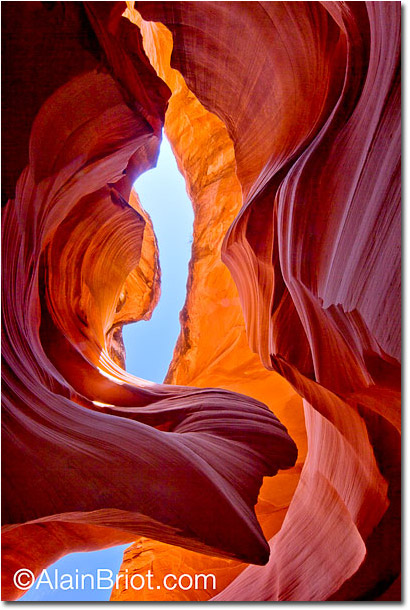Accept the challenges so that you may feel the exhilaration of victory. General George Patton
1 - Introduction
Fine Art Photography is an artistic process. As such it presents a number of specific challenges. In this essay we are going to see at what those challenges are. We are also going to look at a variety of solutions that can help us solve these challenges and become successful fine art photographers.
2 - Showing what you feel, not just what you see...
To be art a photograph cannot just show what you saw. It also has to show what you felt. It has to show not just the subject but also your emotional response to this subject.
Showing what you felt is one of the biggest challenges offered by fine art photography because it involves showing emotions, not just objects.
If you have difficulties doing this, ask yourself what moves you? What subject makes you emotional? What subject gets you fired up, excited and emotional?
Being able to share emotions visually with your audience means solving one of the most important challenges presented by Fine Art Photography.
3 - Nature and Personal Style
One of the most important challenges is finding out how to develop a personal style while photographing a subject that we cannot change in any way in the field.
As landscape photographers, nature is our subject. Unfortunately, we cannot change nature. We cannot move the rocks, change the clouds, modify the weather or alter any of the elements of nature. Nature is the same for all of us. So how can we make it personal? How can we make it look unique?
Nature is not under our control. However, what is under our control is deciding at what time of day and year we are at a specific location, how to compose the photograph when we are there, what lens to use and whether we will stitch several images together or not. What is also under our control is what we do to the photograph after it is taken. The way we convert the image, the way we change colors and contrast, the way we crop the image, the way we distort or warp the image, as well as all the other things we can do during image processing and optimization. All these things are fully under our control.
We cannot change nature. However, we can change how we make nature look like in our photographs. Learning how to do so in a way that is unique is the key to developing a personal style.
4 - Movement and Personal Style
Many photographers and artists confuse art movement and personal style.
A movement is a group of artists working along the same artistic ideas. Surrealism, impressionism, modernism, etc. are art movements. Inventing a new art movement happens rarely.
A personal style is the recognizable style of a single artist working within a specific art movement. Van Gogh, Cezanne, Monet, etc. were all part of the impressionist movement. Yet, each of them developed a unique personal style. We use this style to recognize their work. At the same time we know they all belonged to the same movement. Developing a personal style happens regularly.
Within a given art movement individual artists each have a personal style. What you need to develop is a personal style. You do not need to create a new art movement. Of course, if you do, so much the better, but it is a tall order, beyond the goal of this tutorial.

5 - Style and Personal Style
You need to create a personal style. However you need to learn someone else’s style before you can develop your own style. You do so by learning then practicing the style of another artist. This is because a personal style is almost always the extension of someone else’s style.
Style leads to Personal Style. Once you have learned a style, the next step is to personalize this style to make it your personal style.
6 - Personal Style Must be Personal
The words "personal style" refer to a style that you developed and that you personalized afterwards. If you do not personalize a style then you only have a style, not a personal style. If you do not develop a style then there is nothing to personalize. You are just being “different” at best and most often you are just “being” or “doing” without being any different from anyone else. There’s a lot of people out there who claim to be ‘different’ but who are actually all similar.
7 - The Ego Issue
We need to solve the "ego" issue. Art is by nature an egotistical endeavor. However, no artist can be successful if they do not attract an audience. In other words, you cannot just please yourself when you create art. You also have to please an audience. Otherwise, no one will come to your shows and no one will buy your work. You have to get an audience interested in your work in order to bring awareness to your work. If nobody cares about your work, no one will pay attention to what you do. The only way to interest an audience in your work is to consider how your work benefits them.
8 - Art and Technology
You need to focus on the art, not the technology. Yet, you must use technology to create photographs. Resolving this conflict is difficult. On the one hand you must use technology to create images, on the other hand your images should not be about technology.
9 - Selling Art and Selling Out
To practice fine art photography as a profession you need to sell your work. However, to remain true to your personal artistic inspiration you cannot “sell out” to the audience. In other words you cannot create work just because you know your audience will buy it. Instead, you have to create the work you want to make and find an audience interested in buying this work.
People often blame artists for "selling out" but people rarely ask if they sold out themselves. Selling out occurs in professions other than art. The pot may be calling the kettle black more often than we think.
How many (insert specific profession here) do it for the cash or for the true love of the work? To what extent are they primarily concerned with maintaining their lifestyles?
10 - Know precisely what you can and cannot control...
The implication of the previous section is that we need to know precisely what we can and cannot control. To this end the best is to make two lists: on the first list write all the things that you can control. On the second list write all the things you cannot control. Once that is done, throw away the list of things your cannot control and focus our efforts on the things you can control.
11 - Longevity
Success in art, as in many other professions, does not happen overnight. One has to work for years before achieving recognition for his work.
If you get discouraged because your first couple of shows did not bring you the success you expected, you will be joining the ranks of the multitude who erroneously believe that success in art is a matter of showing your work. It is not. Success in art is being able to take rejection and keep on working with continued vigor. To be successful, one has to be in it for the long run.
12 - Rejection
You have to have an armor-plated ego. How far do you think any artist would get if he didn't have an armor-plated ego? The process of rising to prominence is, in fact, heavily dependent on such a character trait.
As an artist, I learned a long time ago that more people are going to say no than are going to say yes. You just have to ignore it and keep going. What matters are the Yes-Sayers, not the No-Sayers.
13 - Innate Abilities
Someone told me once that I was born with the ability to take great photographs. That’s not only inaccurate, it is a gross misconception. No one is born with the ability to take great photographs because cameras are machines and the knowledge required to use a camera is not innate. It is not part of our DNA.
If anything some of us are born with the ability to perceive things differently, and some of us have different innate skills. For example, some of us may be more right brain (artistic) or left brain (analytical) oriented. Others may have a stronger visual or other skills.
However, knowing how to use a camera, knowing how to process and optimize a photograph, knowing how to print it to fine art standards, and knowing how to mat it and frame it is not something we are born with. All these are things we need to learn.

14 - Understanding Criticism
One of the main hurdles to expressing our personal vision is fear of criticism. It is the number one reason why many either quit or never get started in the first place. However, criticism is there to stay. Rather than fear it, we need to understand it. Most importantly, we need to know what to do when our work is the subject of criticism.
Criticism will undoubtedly come your way. To successfully ‘fend it off’ you need to develop an armor plated ego and know the difference between facts and opinions. This is just the top of the iceberg so be sure to read my 3 parts essay on this site titled Understanding Criticism for an in-depth discussion of criticism.
15 - Fear and Vision
Vision is unique to all of us. We are all unique. We must know what makes us unique and believe that we are unique in order to express a vision. If we do not, then our vision cannot be unique.
Knowing what makes us unique starts by discovering what is unique about us. This can take some time. Many people have never thought about this before, or they may have been told that they are not unique.
How do you find that out? All you have to do is find out what you already know intuitively, find out what you may not have put into words yet.
It is about finding out what makes you who you are. What you believe in, what you think is right and wrong. Find out what you like and dislike. What are your opinions on various subjects, and specifically about art and photography ? Find out what you are passionate about. What makes your heart beat faster. What you love, and, by implication, what you dislike.
And of course, because photography is a visual medium, it is about finding out what you want to show to others and how you can show it. But this part, the what and how, does not have to come out now. It can come about later. Now, what we need is to find out about us, about who we are. Only later, do we need to find out the remaining parts. One thing at a time. Let us focus on ourselves first. Later, we will focus on what we want to say to others and how we want to say it.
16 - Confidence
You must trust in your abilities and develop self confidence if you do not have it yet. In order to do so we need to learn how to deal with adversity. There are challenges on the road to expressing our vision and personal style, and outlining what those are is the purpose of this presentation. To sum it up we need to learn how to:
- Trust our feelings and intuition to be a valid motivation for the creation of photographs
- Create a personal style in a subject that everyone else has access
- Move past the belief that "everything has already been done"
- Get started instead of making excuses why we are not starting
- Listen to our intuition instead of listening to what other think we should do
- Understand the difference between art movement and personal style
- Understand how not to sell out
- Know how to stay motivated when things get challenging
Comments on NPN landscape photography articles? Send them to the editor. NPN members may also log in and leave their comments below.
 Alain Briot creates fine art photographs, teaches workshops and offers DVD tutorials on composition, conversion, optimization, printing and marketing photographs. Alain is also the author of Mastering Landscape Photography. Mastering Photographic Composition, Creativity and Personal Style and Marketing Fine Art Photography. All 3 books are available from Amazon and other bookstores as well from Alain’s website.
Alain Briot creates fine art photographs, teaches workshops and offers DVD tutorials on composition, conversion, optimization, printing and marketing photographs. Alain is also the author of Mastering Landscape Photography. Mastering Photographic Composition, Creativity and Personal Style and Marketing Fine Art Photography. All 3 books are available from Amazon and other bookstores as well from Alain’s website.
You can find more information about Alain's work, writings and tutorials as well as subscribe to Alain’s Free Monthly Newsletter on his website. To subscribe simply go to www.beautiful-landscape.com and click on the Subscribe link at the top of the page. You will have access to over 40 free essays by Alain, in PDF format, immediately after subscribing.

Alain welcomes your comments on this essay as well as on his other essays. You can reach Alain directly by emailing him at alain@beautiful-landscape.com.